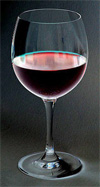





Tips on Bottle Aging
Written By: SUSANNE LOMATCH
PAGE 3 ...
Armed with the data from the winemaker, the goal then is to predict the course in time of
phenol polymerization, acid oxidation and ester hydrolysation/esterification in the
controlled atmosphere of a sealed bottle in a temperature-controlled cellar.
So what about temperature and humidity control of the cellar? These are important
factors, particularly a stable temperature. Temperature affects oxidation timelines, as
there is a certain amount of oxygen in the wine prior to bottling, and the type of closure
can affect oxygen entry vs. temp (screw cap, cork, synthetic providing tightest-least tight
seals). I have followed the guidelines, with good results. Reds generally are kept around
55 deg-F (~13 deg-C) and whites are kept around 48 deg-F (~9 deg-C). Humidity is also
a factor (60% relative is recommended), but less easily controlled unless one has a
storage unit or custom-built cellar that includes humidity environmental control. It is
expensive. The primary reason to have it is to protect the cork from expansion and
contraction. Some older wines will seep as corks dry out, but my experience has been that
this occurrence is uncommon with a temperature-controlled storage unit – I’ve only had
one or two wines that seeped. If you are serious about wine aging, do not assume that a
closet or a natural cellar will be sufficient to deliver the temperature control you need.
Invest in a wine storage unit, or install environmental controls in your natural cellar. I can
recommend the unit I purchased here.
For those that have the time and tenacity, experimenting with cellar aging can be a
gratifying way to achieve the balance and character that brings pleasure in drinking a fine
aged wine. The most exciting dividend can come from less expensive wines. Along your
aging voyage, don’t forget to try some of the bottles to see how the aging is progressing –
buy more than one bottle if the wine has exceptional potential.
 Rapere art pósterús - Salute.
Rapere art pósterús - Salute.
(Check back here periodically for more articles on this topic. As research on aging wine
progresses and becomes more readily available, I will report on the salient points!)
General Guidelines on Aging Periods for Varietals and Varietal Blends:
Bordeaux: 10-30 years
Sauternes: 10-30 years
Nebbiolo-Barolo: 10-20 years
Cabernet: 10-20 years
Syrah: 10-15 years
Zinfandel: 5-10 years
Merlot: 4-7 years
Pinot Noir: 5 years
Barrel-aged Whites: 3-7 years